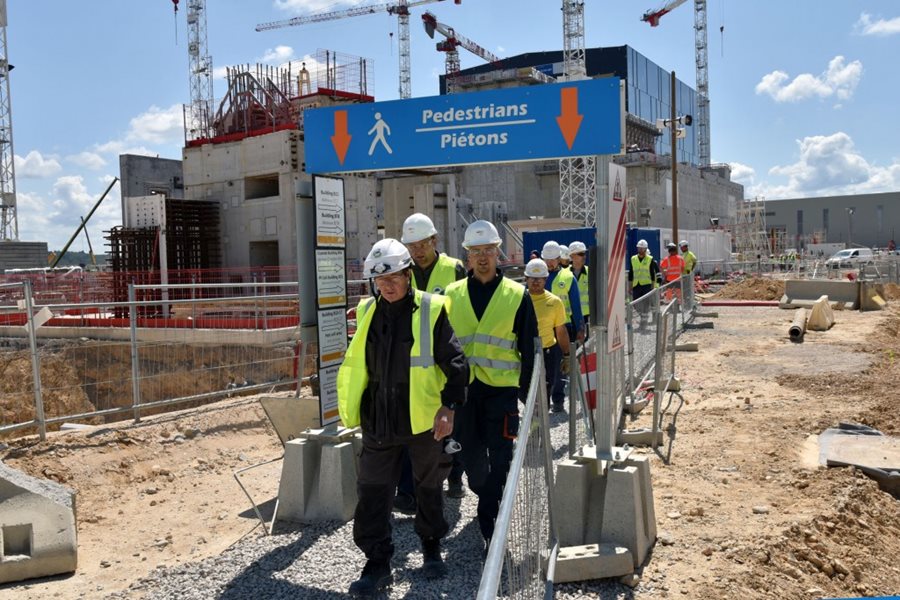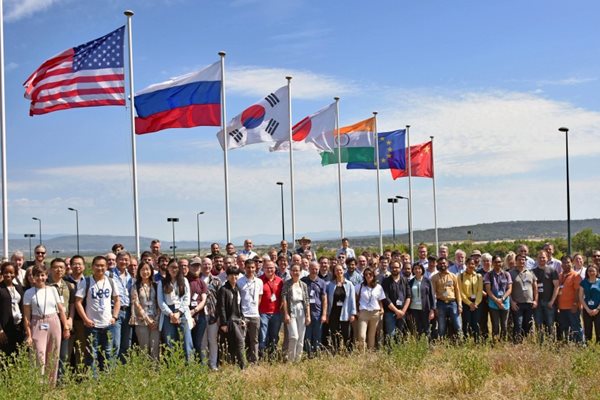
you're currently reading the news digest published from 03 Jun 2019 to 10 Jun 2019
featured2
of-interest2
press2
featured
Worksite | A frontier town at the frontier of science
Like a frontier town of the American West, the ITER site grew from nothing to a thriving community of several thousand people in less than one decade. The original settlers waited almost five years to see the first buildings come out of the ground, but from then on development went very quickly. One by one, ITER acquired the attributes of a small town—roads and traffic lights, an infirmary and a fire brigade, restaurants, public transportation, law enforcement, waste collection ... and even a weekly newspaper. Small-town ITER is an international enclave in a national territory. Although small (~180 hectares) it is very cosmopolitan; its denizens hail from more than 30 countries and speak some 40 different languages. Entering the enclave requires a special passport in the form of an access badge. There are precisely 6,610 badge holders and an average of 5,000 entries per day, not counting visitors on business and 'tourists.' The ITER outpost is both residential and industrial. More than half of its daily population heads directly to the construction site, factories, or workshops; the other 'inhabitants' enter offices in the stately Headquarters building or in more modest edifices scattered around town. ITER is a boomtown that almost never sleeps. Office dwellers start early and often stay late, while construction workers are on a two-and-a-half shift schedule—some of them working into the wee hours of the morning to lay the groundwork for the next day's activities. Whether in offices, workshops, or partially completed buildings, a sense of urgency prevails. Roads and dirt tracks crisscross the town and traffic is intense, with an average of 300 trucks passing through the gates of the enclave every day. Supporting the life of the town requires huge amounts of material—rebar to reinforce the concrete produced in the on-site batching plant, huge formwork panels, steel columns, pipes by the kilometre, tonnes of paint, and all the indispensable supplies for what is probably the largest construction project in Europe, if not the world. Like other frontier towns, small-town ITER is a hub of activity in an otherwise sparsely populated region. The town itself is not very large but it hosts some of the most massive structures ever erected. Its landmark edifice, the ziggurat-like Tokamak Complex, will be 15 percent heavier than New York's Empire State Building when completed. More than 16,000 tonnes of steel rebar and 150,000 tonnes of concrete will have gone into its construction. Electrical power must be managed; water for both drinking and industrial purposes distributed; waste collected, managed, and recycled whenever possible; roads and dirt tracks maintained; food and health services made available; and the 'law,' principally in the form of safety regulations, enforced. For the moment only a fraction of the capacity of the electrical switchyard on site is being used, but as more and more plant systems come on line with requirements for ventilation and air conditioning, consumption will rise steadily. Soon, it will be equivalent to that of 12,000 homes, approximately 20 percent more than the nearby city of Manosque. The consumption of potable water, on the other hand, averages 16 litres per day/per person—considerably lower than the 150 litres that a citizen consumes on average (small-town ITER has a few showers but deliberately ignores bathtubs). Industrial water is needed in huge quantities, however, for producing concrete (300 litres per cubic metre), for sprinkling on dirt tracks in the case of persistent dry weather (200 to 300 cubic metres per month), and for cleaning trucks, pipes and cement mixers—all in all an annual consumption in excess of 20,000 cubic metres, coming partly from the neighbouring Canal de Provence and partly from batching plant water recycling. Waste in town is managed with environmental protection in mind. The 'inert waste' generated by construction activity at the rate of 1,000 tonnes per month (essentially concrete chunks and residue) is transformed into construction aggregates at a plant off site. Other specific types of waste are managed and recycled according to strict regulations. Since painting operations began in the Tokamak Complex, for example, approximately 10 tonnes of empty paint pots, used rollers and chemical containers, and residues of resin are managed every month. Small-town ITER is not a rowdy settlement: speed limits and traffic lights are respected and safety rules scrupulously observed. However, whenever necessary, the law is there to reprimand, punish or even, on extremely rare occasions, expel. Whereas one is free to dress as one likes in the residential part of town, simple and strict rules apply to the construction site: long pants, protective shoes and goggles, gloves, reflective vests. And of course the hard hat—green for law enforcers, blue for managers, red for foremen and supervisors, white for workers, and yellow for visitors. Most frontier settlements become attractive to tourists long after their heyday is over and they have turned into ghost towns. However, because small-town ITER is so unique and spectacular, it draws an average of 15,000 visitors every year—government officials, an occasional prince or princess, business executives, researchers, students and schoolchildren, pensioners, and vacationing families. Most of them discover the town's landmarks through the windows of a tourist bus. The privileged few—but they amount to hundreds—take the VIP tour inside the town's most stunning monuments. These privileged 'tourists' are a challenge to the green hats whose mission is to ensure that co-activity is carried out safely and smoothly, and that all occupational safety regulations are respected. But they acknowledge that visitors are important as they spread the word about the small frontier town at the frontier of science. A frontier town would not be complete without a mayor and a sheriff. In small-town ITER, Laurent and Georges play the parts to perfection. Although hailing from different generations (Georges is long past retirement age), they are both veterans of large nuclear projects. Laurent likens his role to that of the 'conductor' of a large symphonic orchestra playing an utterly complex sheet music; Georges is an enforcer as much as a facilitator—an old-school construction hand in a futuristic project. The day will come when the dusty, bustling frontier settlement gives way to an immaculate research centre where lab coats have replaced hard hats and yellow vests. As the ITER Project writes history, the memory of the small town that nurtured its early years will fade. But its ancient dwellers will still be on hand to tell its story and turn it into an epic saga—which, in many ways, it was.
EPICS | An arena for cooperation
Like the system of nerves in the human body, ITER's control system will connect the ITER 'brain' (control room systems) to its eyes and ears (sensors and diagnostic systems) and its muscles and intestines (magnets and conventional systems). Implementation takes the form of a free and open-source software package called EPICS (Experimental Physics and Industrial Control System) that has evolved over 30 years of use by scientists around the world. EPICS software is used to create distribute soft real-time control systems for scientific instruments such as particle accelerators, telescopes, experiment beam lines, and other large scientific instruments. Two times a year, EPICS collaboration meetings offer developers and managers from the various sites the opportunity to report progress, share experience and discuss ideas for future development. Users are given the chance to see what is being done at other laboratories, and to review the specifications for new tools or enhancements in order to maximize their usefulness to the entire community and avoid duplication of effort. Hosted by an institute using EPICS—and alternating between Europe, the United States and the Asian-Pacific region—meetings usually last five days and include workshops on special topics and training sessions. Last week, for the first time in 10 years, it was again ITER's turn to host an EPICS collaboration meeting. Just over 100 participants from 43 institutions converged on ITER to convert the ITER amphitheatre into an arena for the exchange of knowledge and ideas. From more than 60 presentations during the main meeting, participants took home notes full of new ideas and possible solutions for their systems. Anders Wallander, head of the ITER Control System Division, points out the advantages: 'ITER is an active participant in the EPICS collaboration and the face-to-face collaboration meetings provide an opportunity to build relations and align development and testing efforts, with associated cost savings for all parties.' The Control System Division used the opportunity to show the EPICS community how ITER plans to use the latest developments. A guided tour of the construction site and demonstrations of the virtual reality room completed the meeting program. As Anders Wallander puts it: 'By hosting the EPICS collaboration meeting, ITER benefits from raising the awareness of the project in the worldwide control community and may attract talented future staff.'
of-interest
INFUSE: new US program aims to accelerate fusion research
The US Department of Energy (DOE) has announced the launch of INFUSE, a program created to encourage partnerships in fusion research between industry and DOE national laboratories. The Innovation Network for Fusion Energy (INFUSE) will select a number of projects for awards between $50,000 and $200,000 each, with a 20 percent project cost share for industry partners. Of particular focus will be "enabling technologies" that could contribute to accelerating the development of fusion energy such as new and improved superconducting magnets, materials science, diagnostics, modelling and simulation, and experimental capabilities. DOE's Oak Ridge National Laboratory (ORNL) will manage the new program with the Princeton Plasma Physics Laboratory (PPPL). ORNL's Dennis Youchison, a fusion engineer with extensive experience in plasma-facing components, will serve as director, and PPPL's Ahmed Diallo, a physicist with expertise in laser diagnostics, will serve as deputy director. "I am excited about the potential of INFUSE and believe this step will instill a new vitality to the entire fusion community," says Youchison in the DOE press release. "With growing interest in developing cost-effective sources of fusion energy, INFUSE will help focus current research. Multiple private companies in the United States are pursuing fusion energy systems, and we want to contribute scientific solutions that help make fusion a reality." The first call for proposals has been issued (deadline 30 June). See the 4 June press release and the INFUSE website.
The Economist: podcast on fusion
Fusion is the star of a recent Babbage podcast from The Economist, which aired on 5 June 2019. In "Fusing the future—a power struggle," science correspondent Alok Jha investigates the technology "that could solve all of the world's energy problems in a stroke." Moving from the ITER Project—the "world's make or break fusion experiment"—to private startups, he investigates how close we are to the long-promised dream of nuclear fusion. Featuring interviews with Bernard Bigot, Director-General of the ITER Organization; Stephen Dean, Fusion Power Associates (US); Melanie Windridge, plasma physicist and author; Nicholas Hawker, CEO of First Light Fusion (UK); and David King, Executive Vice Chairman of Tokamak Energy (UK). Listen here (runtime: 20 minutes).



